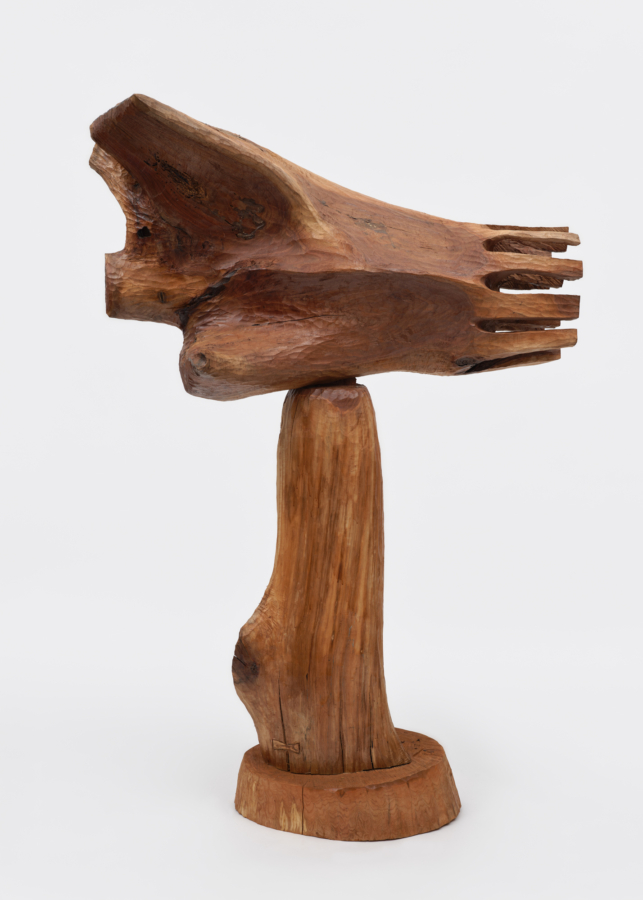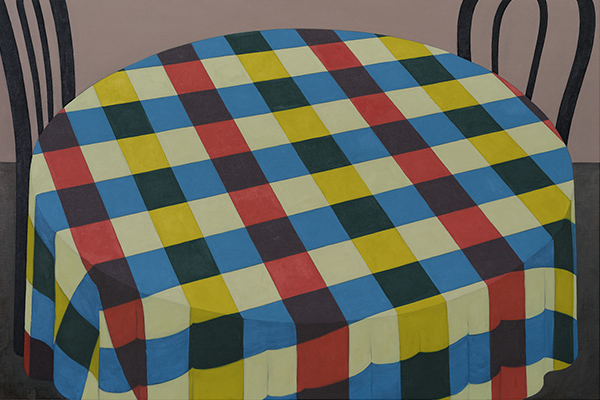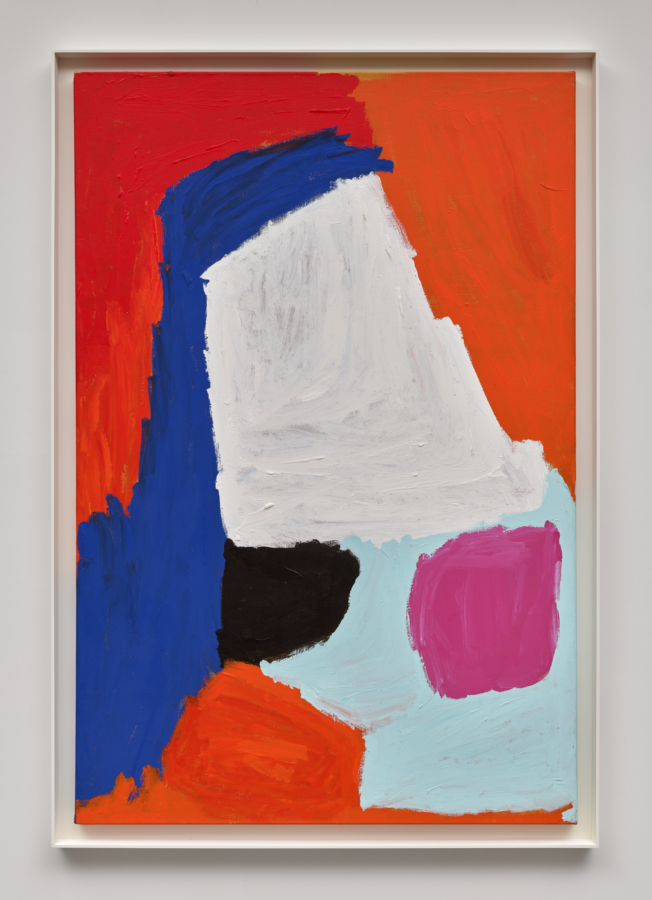March 12, 2023
HENRI MATISSE & JONAS WOOD, Nahmad Contemporary, March 12, 2023
What comes first, the empty chair or the blank canvas? Both are essential to the painter. I suppose we can all imagine the anxiety and the thrill of the empty canvas. In some ways, this enthrallment is part of the definition of being a devoted art lover. We tend to be drawn to the visual, to the effects of light and color. We are also drawn to the drama, the mystery of how the picture is made. We marvel, however discreetly, at where the image, the inspiration, and the skill come from. When we extoll the virtues of a painting, we stay focused on its appearance; when we attempt to account for its effect on us, we are partly acknowledging the unseen drama of its transformation from a blank canvas into a work of art.
And then there’s the chair. Every artist’s studio I have ever visited has had a chair, that chair. It’s never a nice chair. In a painter’s studio, this chair can be particularly grubby, covered in a mangey skin of smeared, dry, and flakey paint. Such a chair often floats in the middle of the room, unattached to a coffee table, released from any home décor “conversation-nook” obligations. This chair is not for reading. This chair is a seat of judgment. This is the artist’s chair. The chair they sit in to review their labor. I have often wondered what the world would be like if every profession had this protocol, if everyone had to sit alone, quietly, and look, contemplate, and take in the fullness of what they were doing as they were doing it.
In the history of art, the chair had a big moment at the beginning of the twentieth century. In his defining aesthetic statement, “Notes of a Painter” (1908), Henri Matisse enshrines the chair as part of the very meaning and role of art. He did so, ostensibly, from the position of the viewer rather than the maker. It’s a famous quote— so famous that Matisse gets a bad rap for it—where he wishes for the effect of art to be “a soothing, calming influence on the mind, something like a good armchair which provides relaxation from physical fatigue.”1 Imagine how many brash young artists in art school had to wrestle this idea to the ground, how many times this anodyne statement of luxurious time had to be jettisoned for the sake of any number of revolutionary aims—aesthetic or otherwise. I, too, once made of Matisse a bad object and could only see his work as hopelessly bourgeois. Though with time, and a considerable amount of studio visits, I no longer see his evocation of the armchair as simply passive. Instead, I began to see the armchair as the chair in the artist’s studio, a chair that offers release from the physical exertion of painting but does not offer an escape from searching self-criticism. For it is within this chair that the artist perfects their craft, sees how to make the picture better, and wonders (sometimes with great ambivalence and doubt) what the picture has to offer to this extraordinary history—nearly 500 years’ worth—of paintings.
I imagine that sometimes when Jonas Wood sits in the chair in his studio and looks critically at his own work, he thinks about Matisse. In some pedestrian way, this must be true because he has copied and reformatted Matisse’s magisterial The Red Studio (1911). He did so by shrinking its grandeur and containing it in one of his signature painted ceramic vessels, incorporating it into his own highly developed personal iconography (Mini Red Pot #1 [2016], p. 42). It’s an audacious move. The appropriation and repetition of such an iconic image runs the risk of being seen as kitsch, vainglorious, or derivative. And yet I find it to be none of those things. To my way of thinking, it’s a mixture of bravery and vulnerability, for it acknowledges love and affection, as well as awe and humility, as the drive for making pictures. If, as the art critic Douglas Crimp once wrote, “underneath every picture is another picture,”2 then Wood is pulling back the curtain and revealing which pictures are underneath his pictures. There’s no cat-and-mouse game here. Instead, the painter is letting us know where he has been; he bares himself by making an image of his aesthetic DNA.
And surely Matisse provides a lot of the DNA for Wood. There are the heavily patterned surfaces—carpets, drapes, wood grain, wallpaper, upholstery, tiled floors. There are the vases overflowing with flowers. There are the open windows with glimpses of sultry and idyllic landscapes. There are the family vignettes. There is the use of pattern to insist upon the flatness of the picture plane, to assert the fecundity of nature, to claim the decorative and the beautiful. There is the riotous palette, a constant play with high-key colors designed to keep the eye moving around the canvas. There is the veritable dictionary of marks—short strokes, hatch marks, stippling, and daubs and blobs of paint. Each announcing itself as a painterly mark even as it is subsumed into the greater task of making a mimetic image. Wood is an excellent student. He takes all the attributes of a Matisse painting and retools them; in the retooling, he does not merely tip his hat to their origin, he makes these painterly strategies his own.
It’s precisely the palimpsest nature of his painterly project that makes the literal pairing of Matisse and Wood so productive. While we all remember the armchair line from “Notes of a Painter,” we tend to forget that the essay also includes this telling sentence about what painting means: “there are no new truths. The role of the artist, like that of the scholar, consists of seizing current truths often repeated to him, but which will take on new meaning for him and which he will make his own when he has grasped their deepest significance.”3 So, whereas Matisse’s engagement with the nude always involves a beautiful woman who was the object of his gaze, in Wood’s oeuvre, nudity is reserved for self-portraiture. Compare, for instance, Matisse’s L’Artiste et le modèle nu (The Artist and the Nude Model) (1921, pp. 10–11) with Wood’s Calais Drive Two (2012, pp. 12–13). Both show the artist at work, labor that is imaged with a degree of ease and expertise. Matisse depicts himself from the back, as if we are in the room with him, peeking over his shoulder while he keeps his gaze firmly trained on the model in front of him. The model is completely naked; her body is torqued awkwardly in her chair so that both the viewer and Matisse can better see her voluptuous hips and shock of pubic hair. As viewers, we are offered the role of interloper or voyeur.
In Calais Drive Two, we see the artist through a paned window: we are inside while he stands poolside. His gaze is unflinchingly directed toward the viewer. Even though Wood deploys a classic trope of voyeurism—we see him through a window— he sidesteps the potential glamor of the shirtless, white male artist soaking in the midday sun. Rather, the windowpanes dissect and refract Wood’s milky torso, whose color evokes his Boston hometown more than his adopted Los Angeles. His hairline recedes into a sharp widow’s peak, and his scrawny knees and hirsute chest are rendered with a remarkable degree of honesty. Here, the artist turns his exacting gaze on himself—he does not “punch down” as they say in comedy. Instead, he looks at himself and the viewer, almost surreptitiously holding a brush in his hand. A canvas still in progress sits next to an empty chair. If Matisse protectively shields himself from our gaze, then Wood catches his own image, as if ensnared in a spider web of his own making.
Herein lies the force of the pairing, because it doesn’t only confirm our sense that Wood is as good a student as Matisse will ever have, it also shows how right Matisse was when he said in “Notes of a Painter” that there are no “new truths.” By which I take him to mean that even by 1908 all the pictures already had another picture underneath them. It turns out that one of the secrets of painting is that novelty is a losing game. Rather, both Matisse and Wood suggest that in order to create believable pictorial space (be it abstract or mimetic), the artist must be engaged with the long durée of painting. The artist must be talking to other artists over the spacetime continuum we call history. What makes a work contemporary, modern, or of its time is the artist’s ability to render the deep time of painting’s history with the everyday time of the painter’s world. In this regard, Wood’s paintings offer an unexpected snapshot of artistic and domestic arrangements circa 2023.
For Matisse, voluptuous nudes or women tending children are staples of the bourgeois interior. Matisse painted hundreds of well-appointed rooms with windows that look outward, but where the roiling patterns that he drapes over his surfaces keep the eye and the energy of the picture ever moving inwards. Matisse’s commitment to the interior allows him to focus on the docile haven of classically arranged heterosexual domestic space within which women appear in two roles. They are either nudes and/or objects of beauty or caretakers of children.
For Wood, nudity is only ever visited upon himself. In his searchingly delicate portraits of his wife, the artist Shio Kusaka, she is always clothed. Even more than clothed, she is typically standing with her gaze steadily directed toward the viewer. Even when imaged in their marital bedroom in Shio and Robot (2008, p. 38), she stands by the edge of the bed smiling, open, wearing a loose-fitting, highly patterned sundress. Wood offers us the 2022 version of a Matissean Luxe, calme, et volupté (1904) vibe: a peaceful easy feeling between and among equals.
When Wood paints his children, they are not in the care of his wife. They tend to appear alone. They, too, look out at the viewer. As small as they are, they are represented as fully human. They are not in someone’s “charge” or possession. They are imaged with as much parity as one can imagine an adult parent offering their young child. Momo sits in her playroom; stacks of toys that double as platonic solids and primary colors await her nubile creativity (Momo’s Playroom #2 [2012], p. 24). A seated Kiki, whose little-boy feet can’t yet reach the floor, wears a sweater decorated with tiger heads while casually draping his arm around what appears to be either an enormous cat or a baby leopard, a real animal or a stuffed plush toy (Kiki with Leopard [2020], p. 27). Either way, this fearless child gazes directly at the viewer, his freckled face still very much a boy, while his bare legs have started to grow the hair of the man he will become.
Wood’s early-twenty-first-century version of family life is indebted to Matisse’s twentieth-century interior spaces. His figures are placed in rooms. These rooms often have windows and doors—apertures that allow for air and movement, the possibility of time’s passage, and a narrative sensibility. Things happen in these rooms, and a large part of what happens is adornment and pattern. Like Matisse, Wood is a colorist. Like Matisse, Wood imagines the flat picture plane as a series of intersecting planes of pattern, or perhaps, more precisely, his rooms are filled with reproductions and representations of pattern. Look how intensely he has reproduced the wood grain of the bench Kiki is sitting on. Look how the wood grain of the bench offers an indoor continuation of the tree pattern that dots the landscape and/or wallpaper behind the child. Here, the unruly bounty of the natural world is mirrored in the tame relations between child and pet. Part of what we glean from Wood’s investigations of the very same subject matter that concerned Matisse is the degree to which the inherent rights of women and children to their full personhood are part of Wood’s ethical worldview. While many are in awe of Wood’s capacity to make mimetic pictures that borrow abstract expressionism’s allover composition (a pictorial devise that was, in part, metabolized from Matisse’s The Red Studio, in which the flat, plane of color is the structuring device of the whole picture), I wager that the deeper emotional valence stems from the equity with which he images his children and the parity with which he depicts his wife.
In terms of subject matter, there is one place where Wood parts ways with Matisse. Matisse was clear that he was interested primarily in the figure. In “Notes of a Painter,” he writes: “What interests me most is neither still life nor landscape, but the human figure.”4 Wood is clearly interested in landscape, not as sublime, not as allegory, and not even as particularly imperiled (which we know it is). Wood does not offer the unbounded realm of nature. He gives us the landscape we know best—the one seen framed by a window. The structure of Hanalei View and San Bernardino View with Skier (both 2022, pp. 16 and 45) is the same: the bottom edge of each picture doubles as a window ledge, and the top third of each painting indicates the top of a window sash or windowpane. Matisse asked that painting be true to the time: “All artists bear the imprint of their time, but the great artists are those in whom this is most profoundly marked.”5 Wood gives us the nature that twenty-first-century subjects know best—the tourist landscape through a window. Anyone following Wood’s oeuvre knows of his consistent concern with flowers and potted succulents and his attention to the infinite variety of textures and colors that exist in our verdant world. Indeed, he seems to have set himself the task of developing a language of marks commensurate with the heterogeneity and pattern logic of nature. As soaring and remarkable as these landscapes are, they almost always bear witness to our contemporary reality. They always contain a detail that shows the measure of our humanity, such as our smallness (look at the skier at the bottom of San Bernardino View with Skier) or our unthinking omnipresence (see the electrical lines in Hanalei View).
In other words, while Wood makes pictures that mine painting’s deep history— pictures that show the traces of where he comes from, what he loves, and what concerns him—he is also at work depicting the world we share in our current moment. In the swirl of pattern and mark-making, in this world of painterly feints and expressive color, his canvases show both the past (the history of how pictures are made and how they appear) and the present (the perpetual unfolding of the individual in relation to themselves, society, and nature). Sometimes it’s hard to see the present head-on. It’s hard to take oneself out of the daily flow to look squarely at where we are and where we have been. This is the crucial role of the chair in the artist’s studio. It is the perch from which the artist makes sense of the world. If we are lucky, we can join them; we too, can find a chair from which to take it all in.



